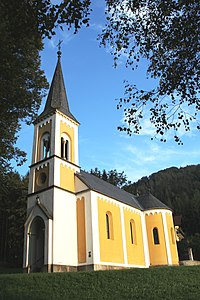Viktor Seßler Freiherr von Herzinger
Viktor Seßler Freiherr von Herzinger (born December 10, 1836 in Vienna , † January 14, 1899 in Graz ) was an Austrian coal and steel industrialist and politician. He ran several iron and steel works and owned extensive land holdings in Upper Styria . From 1868 to 1873 he was a member of the Styrian state parliament .
Life
Viktor Seßler was the grandson of the Vordernberg master wheeler Josef Seßler , who is considered the industrial pioneer of Upper Styria, as he had already built a rolling mill near Krieglach around 1840 and a blast furnace near Vordernberg and thus supplied all of the iron for the construction of the Semmering Railway . After his grandfather's death, Viktor Sessler inherited all of his property at the age of six.
After graduating from high school and serving as an officer in the Austrian army for several years, Viktor Seßler finally took over the management of all family-owned iron and steel works in the Mürz Valley as well as the agricultural goods Großlobming and Farrach , the mining in Fohnsdorf and others in 1861 Properties in the upper Mur Valley . Seßler's works were considered technically particularly advanced, not least because of the innovative ideas of his uncle, Carl von Prevenhueber. From the late 1860s, Seßler ran into economic difficulties and in the following years sold significant parts of his works to the Vordernberg-Köflacher-Montanindustrie-Gesellschaft, a forerunner of the Österreichisch-Alpine Montangesellschaft .
Since he had a great need for charcoal for his hammer and iron works, he bought farms around Krieglach, the closer home of the writer Peter Rosegger . Rosegger took up this topic in his 1887 novel Jakob the Last . The historian Othmar Pickl assumes that the figure of the camplord , a rich industrialist who deprives the farmers of their property, was modeled on Viktor Seßler.
In addition to his industrial functions, Seßler founded the Steiermärkische Escomptebank and the Stadtsparkasse Judenburg and was involved in various charitable activities. In 1870 he donated his art collection in his will to the Alte Galerie Graz , to whose holdings he made a significant contribution.
In 1858 he married Helene Freiin v. Herzinger (1836–1882), daughter of a field marshal lieutenant. In 1866, Seßler was given the title of knighthood by Herzinger, and in 1869 to the rank of baron . After the early death of his wife, Seßler had the Gölkkapelle near Krieglach rebuilt or expanded as a grave chapel with a family crypt. He was also buried in the chapel after his death.
literature
- Seßler von Herzinger, Viktor Felix Frh .. In: Österreichisches Biographisches Lexikon 1815–1950 (ÖBL). Volume 12, Verlag der Österreichischen Akademie der Wissenschaften, Vienna 2001–2005,ISBN 3-7001-3580-7, p. 195.
- Constantin von Wurzbach : Seßler von Herzinger, Victor Felix Freiherr . In: Biographisches Lexikon des Kaiserthums Oesterreich . 34th part. Imperial-Royal Court and State Printing Office, Vienna 1877, p. 157 ( digitized version ).
- Othmar Pickl : Josef Seßler and the beginnings of the Mürz Valley iron industry. in: Ferdinand Tremel (Ed.): Styrian entrepreneurs of the 19th and 20th centuries. A collection of images of life. ( Journal of the Historical Association for Styria , special volume 9). Graz 1965, pp. 28-33.
- Manfred Weissenbacher: The Seßler (-Herzinger) family and their punch mills in the 19th century . in: Blätter für Heimatkunde, Vol. 83, Graz 2009 ISSN 0006-4459 pp. 32–51
| personal data | |
|---|---|
| SURNAME | Seßler Freiherr von Herzinger, Viktor |
| ALTERNATIVE NAMES | Seßler von Herzinger, Viktor Felix; Herzinger, Viktor Felix Seßler from |
| BRIEF DESCRIPTION | Austrian coal and steel industrialist and politician |
| DATE OF BIRTH | December 10, 1836 |
| PLACE OF BIRTH | Vienna |
| DATE OF DEATH | January 14, 1899 |
| Place of death | Graz |

